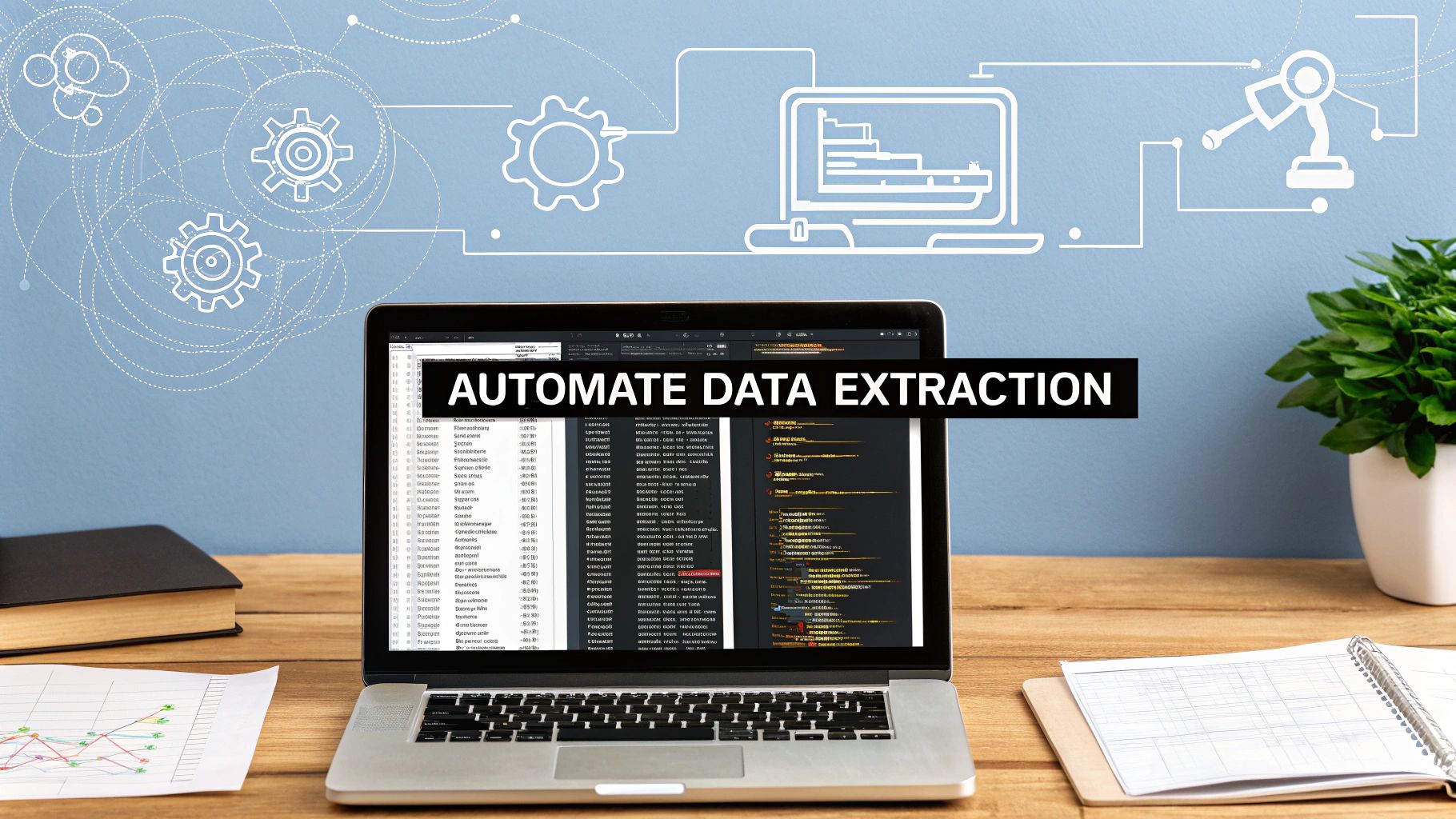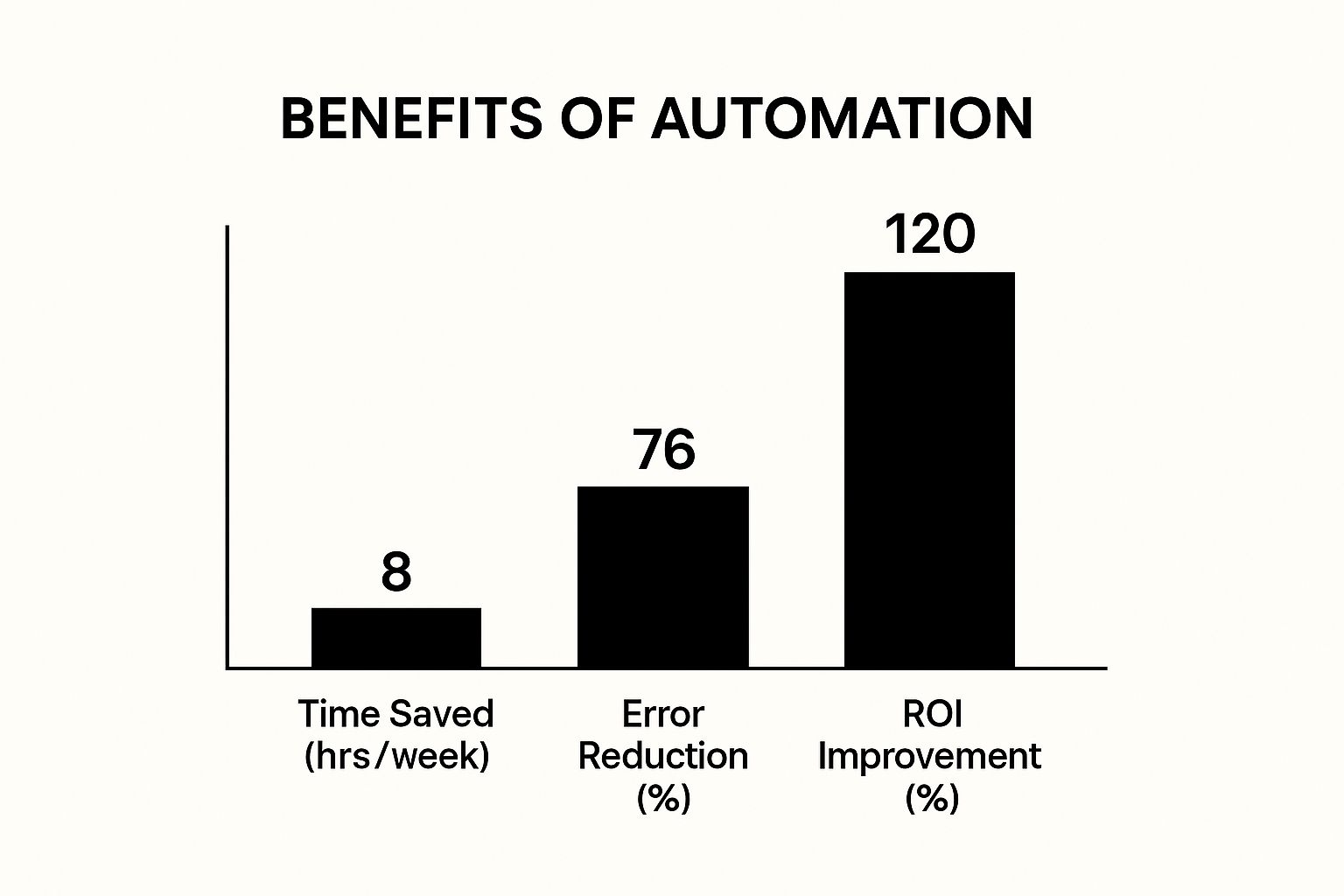Automate Data Extraction Without the Headaches

Automating data extraction is all about using smart software to pull specific information from sources like websites, PDFs, or even images without anyone having to lift a finger. It takes messy, unstructured data and neatly organizes it into a structured format, like a spreadsheet. This is a game-changer for everything from market research and lead generation to keeping a close eye on your competition.
Why Manual Data Collection Is Costing You
In today's fast-paced world, sticking with manual data collection is like trying to win a car race on foot. It’s not just about being slow; it’s about actively draining your most precious resources—your team's time, your budget, and their ability to focus on what really matters. Every single hour someone spends manually copying and pasting information is an hour they could have spent analyzing that data or talking to customers.
And let's be honest, this manual grind is a breeding ground for human error. One tiny typo or a single missed row can throw off an entire dataset, leading to bad analysis and even worse business decisions. The costs of these mistakes aren't always obvious on a balance sheet, but they are very real.
The True Price of Inaccuracy and Inefficiency
The pain of manual data entry isn't just limited to websites. Think about all the time wasted re-typing information from paper forms or invoices. This is where the principles of document workflow automation come into play, transforming a tedious chore into a seamless process. Moving from manual to automatic isn't just a small tweak; it's a fundamental shift in your operational DNA.
When you automate data extraction, you're not just buying software. You're buying back your team's time, slashing error rates, and building a scalable system for gathering business intelligence. Data collection stops being a bottleneck and starts being the fuel for your company's growth.
The real cost of manual data collection isn't just the salary of the person doing the tedious work. It's the missed opportunities, the flawed strategies built on bad data, and the competitive edge lost to businesses that are simply faster.
To really see the difference, let's compare the two approaches side-by-side.
Manual vs Automated Data Extraction
| Aspect | Manual Extraction | Automated Extraction |
|---|---|---|
| Speed | Extremely slow; limited by human capacity. | Incredibly fast; can process thousands of pages in minutes. |
| Accuracy | Prone to human error (typos, omissions). | Highly accurate and consistent. |
| Scalability | Poor; hiring more people is costly and slow. | Excellent; easily scales to handle massive data volumes. |
| Cost | High long-term labor costs and opportunity costs. | Lower long-term costs; high ROI. |
| Employee Focus | Tedious, low-value, repetitive tasks. | High-value strategic and analytical work. |
The choice becomes pretty clear when you lay it all out. Automation frees your team to do what they do best: think, strategize, and grow the business. To start automating today, you can download our Chrome extension and experience the benefits firsthand.
The infographic below really drives home the measurable benefits companies experience when they make the switch.

As you can see, the data speaks for itself. Automation delivers a powerful triple-threat of efficiency, accuracy, and a solid return on investment.
The Growing Need for Automation
The market is buzzing with this need for smarter data solutions. The global data extraction software market is expected to jump from USD 2.01 billion in 2025 to a staggering USD 3.64 billion by 2029.
What's driving this? The sheer explosion of unstructured data online and the rise of AI to manage it. In fact, a recent survey showed that 87% of IT leaders view managing this data avalanche as one of their most critical challenges. It’s no longer a question of if you should automate, but how quickly you can get started.
Your First Automated Extraction in Minutes

Ready to see just how easy it is to automate data extraction? Moving from mind-numbing manual work to an automated flow is a lot faster than you might think, especially when you have the right tool. Let's skip the dense technical jargon and get straight to the good part.
Your first move is to install a simple, no-code tool like our PandaExtract Chrome extension. This isn't about becoming a programmer overnight; it's about adding a powerful new skill directly to your browser in less than a minute. Once it's installed, the extension is just sitting there, ready to go whenever you need it. You can download our free Chrome extension here to follow along.
Activating the Scraper on Your Target Site
Let’s say you’re on an e-commerce site and want to grab all the product prices. Or maybe you're looking at a business directory and need to pull a clean list of names and phone numbers. With the extension installed, all you have to do is navigate to the page you want to extract data from.
Simply click the PandaExtract icon in your browser's toolbar to bring it to life. The tool’s interface instantly overlays on the webpage, waiting for your command. This is the starting point for any data job, transforming a static website into a wellspring of structured, actionable information.
Selecting Your First Data Points
Now for the fun part. Forget highlighting, copying, and pasting. Instead, you'll use the scraper's point-and-click selector. Just hover your mouse over the piece of data you want—a product name, a price, a customer review—and click on it.
This is where the tool gets clever. When you click on one product name in a list, it’s smart enough to instantly recognize the pattern and highlight all the other product names on the page. This "one-click" list detection is an incredible time-saver.
You can build out multiple columns of data just as easily:
- Column 1: Click a product title to get all of them.
- Column 2: Click a price to get all the corresponding prices.
- Column 3: Click a star rating to get every rating on the page.
The data you select immediately populates a clean, spreadsheet-style table right inside the extension, perfectly aligned and ready for you to export. This hands-on process shows just how quickly you can go from zero to scraping with real confidence.
The whole point of a good no-code scraper is to make data selection feel as natural as just browsing the web. If you can see the data, you should be able to grab it with a click.
A great, practical starting point for automation in many businesses is using invoice data capture software to eliminate tedious data entry from PDFs and other documents. The core principle is exactly the same: point to the data you need, and let the software do the heavy lifting.
This first, hands-on experience is all about building your confidence and showing you the power you now have at your disposal. The most complex, time-consuming data collection jobs can often be boiled down to just a few smart clicks. Your first automated extraction is just the beginning of a much more efficient way to work.
Ready to see for yourself? Download the Ultimate Web Scraper now and start getting your time back.
Scraping Modern and Dynamic Websites

Once you get the hang of pulling data from a simple, static webpage, you'll quickly run into a new reality: most of the web isn't that simple. Modern sites are interactive and dynamic, with content that only loads as you scroll, click, or wait. This is a huge hurdle if you need to automate data extraction for a complete and accurate dataset.
Think of static websites like a printed brochure—everything is there the moment you open it. Dynamic sites, on the other hand, are more like living applications. Product listings, search results, or social media feeds often appear only after you take action. A basic scraper might grab the first few items that load and call it a day, completely missing the vast majority of the data. To get the whole story, your tool needs to act more like a human.
Handling Infinite Scroll and Pagination
Two of the biggest roadblocks you'll face are infinite scroll and pagination. We've all seen infinite scroll on sites like X (formerly Twitter), where new content just keeps appearing as you scroll down. Pagination is its cousin, where content is split across multiple pages, forcing you to click "Next" or page numbers to see everything.
This is where most simple scrapers give up. They capture the initial HTML and stop because they don't know how to trigger these loading mechanisms. But a smarter tool, like our PandaExtract Chrome extension, is built for exactly these scenarios.
- For infinite scroll: You can tell the scraper to scroll down a specific number of times or until it hits the bottom of the page. This ensures everything is loaded before the extraction begins.
- For pagination: You just need to click on the "Next" button with the selector tool one time. The scraper instantly understands it needs to repeat the extraction process on every following page until there are no more pages to visit.
This isn't just a minor feature; it's what makes it possible to scrape e-commerce sites with thousands of products or directories with endless listings. Without it, you're only seeing a tiny piece of the puzzle.
Capturing Data Loaded with JavaScript
Another common challenge is content loaded by JavaScript (JS). Ever land on a page where the prices or product details pop in a second or two after everything else? That’s JavaScript fetching data in the background. If your scraper moves too quickly, it will try to grab information that isn't even there yet, leaving you with a spreadsheet full of empty cells.
To reliably automate data extraction on modern sites, your tool must be able to wait for JavaScript to finish its job. This is not a "nice-to-have" feature; it's a fundamental requirement for accurate data collection.
A good no-code scraper solves this by letting you add a delay. You can configure it to wait a few seconds after the page loads, giving all the dynamic elements time to appear on the screen. This simple adjustment makes a world of difference, turning what would have been an incomplete mess into a clean, accurate dataset from even the most interactive sites.
If you're ready to tackle these advanced scraping challenges without touching a single line of code, you can download our powerful Chrome extension and see for yourself how easy it can be.
How Top Industries Automate Data Extraction

The real power of automating data extraction isn't some one-size-fits-all trick. Its value truly comes to life when you see it solving specific, high-stakes problems in different industries. From the fast-paced world of online retail to the data-heavy realm of high finance, smart businesses are carving out a serious competitive edge by putting automated data to work.
This is about more than just clawing back a few hours in the day. It’s about making quicker, more informed decisions fueled by information that’s fresh. A retail analyst simply can't wait a week for a report on a competitor's price drop, and a financial advisor needs market data now, not tomorrow.
E-commerce Competitive Intelligence
In the fiercely competitive world of e-commerce, staying on top means knowing exactly what your rivals are up to. I've seen pricing analysts set up scrapers to constantly pull data from hundreds of competitor sites, tracking everything from price changes to stock levels and new product drops.
Trying to do that by hand? It would be a full-time, soul-crushing job for an entire team. With automation, they can effortlessly:
- Track price shifts daily—sometimes hourly—to adjust their own pricing strategy on the fly.
- Monitor inventory to spot a competitor's supply chain hiccup or identify a hot-selling product.
- Aggregate customer reviews to gauge public sentiment and discover gaps in the market they can fill.
This steady feed of information gives them the agility to react almost instantly to what's happening in the market.
Finance and Market Analysis
The financial sector's need for data is practically endless. In fact, banking, financial services, and insurance (BFSI) have such a massive appetite for information that they heavily influence the entire data extraction market. This sector is actually projected to see the highest growth in the coming years, especially in North America. For a deeper dive, you can check out this in-depth market analysis.
Investment firms automate the gathering of stock prices, market indices, and breaking financial news to feed directly into their analytical models. This allows them to spot trends and execute trades with a speed that manual research could never hope to achieve.
Real Estate Market Trends
For real estate pros, good data is the bedrock of their business. It's common practice to automate data extraction from property sites like Zillow or local MLS portals to get a bird's-eye view of what the market is doing.
By pulling property details—like listing prices, time on the market, and specific features—agents and investors can pinpoint up-and-coming neighborhoods, give clients solid pricing advice, and spot undervalued properties before they hit the mainstream.
This level of market intelligence is incredibly valuable. If you're interested in finding the right tools for your own projects, our guide on the best web scraping tools available is a great place to start.
For anyone working in these fields, automation has stopped being a "nice to have." It's become a fundamental part of daily operations, and thankfully, the right tools make it surprisingly accessible. To begin pulling this kind of valuable data for yourself, download the PandaExtract Chrome extension and see just how straightforward it can be.
Building Your Automated Data Workflow
The real power of automation isn't just about running a single data scrape faster. It's about building a completely hands-off system that works for you 24/7. This is where you graduate from one-off tasks to a true "set it and forget it" workflow that constantly feeds you fresh, valuable information.
What you're really doing is creating a seamless pipeline. Data flows from the web, straight into the tools where you can actually put it to work. This flips the script from a reactive process—"Oh, I need data, let me go get it"—to a proactive one where your systems are always up-to-date, whether you're tracking competitor prices or generating new leads.
Scheduling Your Extractions for Timely Insights
One of the most impactful things you can do is schedule your data extractions. Why would you manually run a scrape every single morning when you can have it done automatically before you even sit down at your desk? With a tool like the PandaExtract Chrome extension, you can set up cloud-based schedules to run your extraction jobs at any interval you need.
Just think about the possibilities:
- Daily: Wake up to a fresh list of real estate listings or yesterday's customer reviews, all neatly compiled in a spreadsheet.
- Weekly: Get a summary of all competitor product launches or pricing changes from the past seven days, without lifting a finger.
- Hourly: For fast-moving markets like e-commerce or finance, you can track stock levels or price fluctuations in near real-time.
Setting up a schedule takes human error out of the equation. You'll never forget to collect data again, and your decisions will always be based on the most current information possible. That's a level of consistency you just can't get by doing it manually. For a deeper dive, our guide on data extraction automation walks through some more advanced strategies.
Integrating Data with Your Favorite Tools
Getting the data is only half the battle. The real value is unlocked when that information flows directly into the platforms you already use every day. A truly automated workflow doesn't just end with a CSV download; it pushes the information right where it needs to go.
A truly automated workflow bridges the gap between raw data and actionable intelligence. It's not about creating more files to manage; it's about making your existing tools smarter.
Think about how you could wire up your extracted data:
- Send to Google Sheets: You could automatically populate a shared spreadsheet with new leads, creating a live database your whole team can access.
- Push to an API: Feed real-time product data directly into your internal dashboards or pricing models for dynamic analysis.
- Connect to Visualization Tools: Link your data to platforms like Tableau or Looker Studio to create constantly updated charts and reports that visualize market trends.
As you get comfortable building these workflows, you can start exploring how clean, automated data can power other advanced applications. For instance, you could see How to Create an AI Chatbot: Your No-Code Guide to understand how high-quality data is the fuel for conversational AI.
This kind of integration turns your extracted data from a static report into a living, breathing part of your business operations. It’s what powers smarter decisions across the board. To start building your own powerful data pipelines, download the PandaExtract extension and explore its scheduling and integration features.
What's on the Horizon for Data Automation?
Once you get comfortable with the tools available today, it's a good idea to look ahead. The data automation space is evolving at a breakneck pace, and the changes on the way will make current extraction tools feel like relics. We're not just talking about getting faster; we're talking about tools that become genuinely intelligent. The future isn't about simply copying text from a webpage—it's about grasping its meaning and context.
The engine behind this evolution is the deep integration of artificial intelligence (AI) and machine learning (ML). These aren't just buzzwords. They are fundamentally changing basic scrapers into intuitive partners capable of making sense of messy, unstructured information. This pushes us past simple tasks like price tracking and into a whole new world of sophisticated analysis.
Beyond Scraping: The Rise of Intelligent Data Interpretation
Think about it this way: imagine a tool that doesn't just grab a thousand customer reviews for you. Instead, it automatically reads them, identifies the sentiment—positive, negative, or neutral—and then neatly categorizes the feedback into themes like "shipping times" or "product quality." That's exactly where we're headed.
The next generation of tools will chew through massive volumes of text from social media, support tickets, and forums, handing you synthesized insights without you ever having to read a single post.
This leap forward is being fueled by major progress in a few key areas:
- Natural Language Processing (NLP): This is what allows a machine to actually read and comprehend human language, picking up on subtlety and intent.
- Text Analytics: This is the magic that finds patterns and recurring topics inside huge walls of text, pulling out the themes that matter.
- Optical Character Recognition (OCR): Modern OCR is incredible. It's no longer just for clean PDFs; it can now lift text from messy images and even videos with surprising accuracy.
This isn't just a niche trend; it's a massive market shift. The data extraction industry is on a trajectory to explode from an estimated USD 6.16 billion in 2025 to a staggering USD 24.43 billion by 2034. That's a compound annual growth rate of about 16.54%, and it's driven entirely by these smarter technologies making data more useful to everyone. You can dig into the specifics in this detailed data extraction market report.
The best tools of tomorrow won't just fetch what you ask for. They’ll start anticipating what you need, connecting the dots across different data sources to give you the full story.
How to Future-Proof Your Data Strategy
So, what does all this mean for you right now? It means the no-code skills you're developing are the perfect launchpad for what's coming next. As AI becomes more seamlessly woven into platforms like PandaExtract, the user experience will only get simpler. Eventually, you'll just describe the business insight you're looking for, and the tool will handle the complex work of figuring out how to get it.
Paying attention to these trends helps you make smarter plans. By getting on board with automation today, you're not just solving an immediate problem—you're getting your business ready to capitalize on the even more powerful capabilities that are just over the horizon.
You don't have to wait for the future to get started. With PandaExtract, you have a robust no-code tool that brings today's best extraction technology right to your browser. See what it can do for you.
Published on